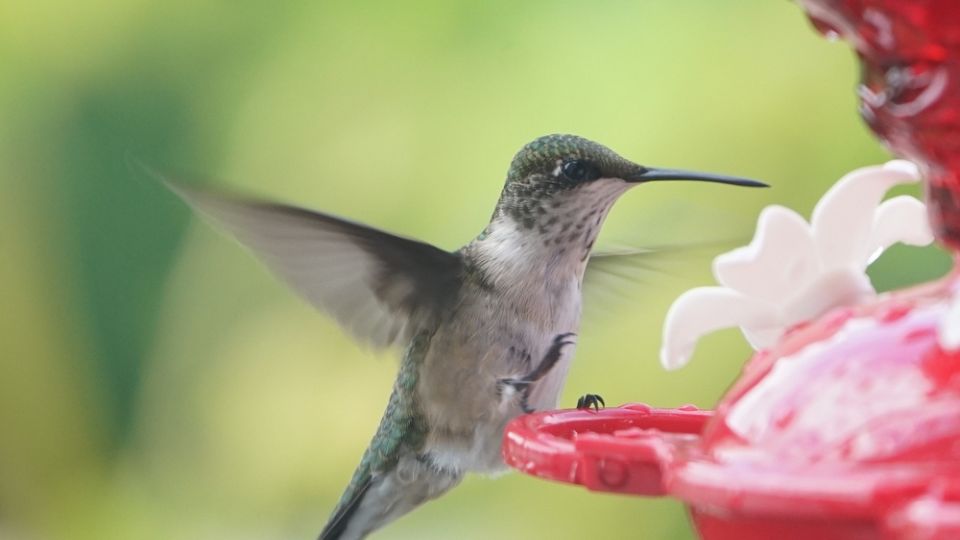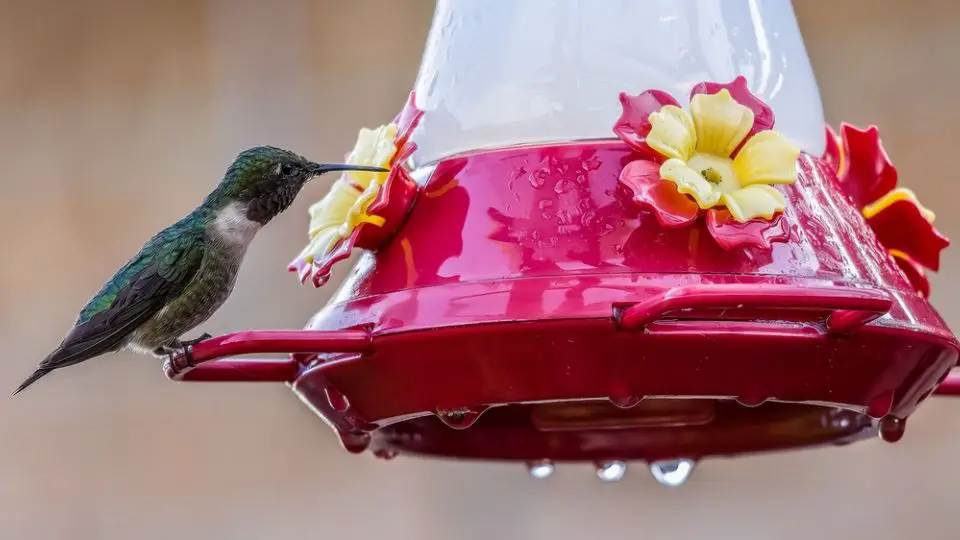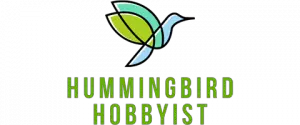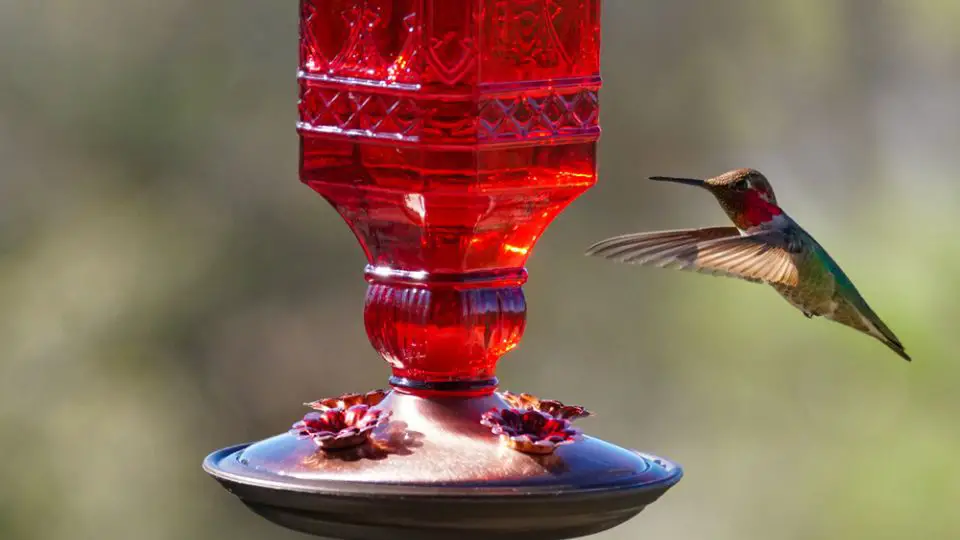Black Mold in hummingbird feeders can often appear. If you notice it, take it down and clean it right away. Homemade hummingbird food consists of sugar and water—it can easily ferment and grow mold. If you notice hummingbirds avoiding the feeder, check for black mold to keep the hummingbirds safe.
Some commercial hummingbird nectars contain red dye and other harmful substances that can also develop mold and harm hummingbirds. Go with homemade sugar water and natural cleaning agents to keep the hummingbirds healthy and happy. Here’s how!
Table of Contents
How Can I Tell if A Hummingbird Feeder Has Mold?
Your feeder is moldy if you see any build-up and black stuff developing on the plastic, bee guards, or floating in sugar water. You should toss away the nectar, clean the feeder thoroughly, and refill it with fresh hummingbird food. The best way to keep hummingbirds healthy and avoid mold is to clean your feeders every time you refill them.
Additionally, if you notice an increased number of bees and wasps around your feeder, it might be a sign that it’s fermented. Insects are naturally attracted to fermented sugar and will try to have a sip. React quickly to help hummingbirds stay healthy. Finally, if you see fewer hummingbirds visiting the feeder, something is wrong, and you should check it out.
Why Is Mold Growing in My Hummingbird Feeder ?
Mold loves humidity and hot weather, which are both present around and in the hummingbird feeders. Feeders are also prone to build-up, which can turn into mold. You’ll usually notice it around feeding ports as these are constantly wet.
Unfortunately, this is precisely where hummingbirds, orioles, and other birds can come in contact with the dangerous substance. Remember, mold growth can be deadly for hummingbirds—so clean the bird feeders upon the first sight of it.

Will Hummingbirds Drink Moldy Nectar?
These wild birds prefer natural flower nectar but won’t complain about additional food sources. Plus, hanging feeders with hummingbird nectar will help you attract the birds in your yard. In general, hummingbirds won’t drink the fermented and moldy nectar regardless of their poor sense of smell.
What’s more, sugar will break into other carbohydrates, reducing the nutritional value of the nectar. Hummingbirds will sense this and stop drinking it. Still, young and inexperienced hummingbirds might drink it even if it is moldy, which is why keeping it clean is essential.
Will Black Mold Hurt Hummingbirds?
Black mold in hummingbird feeders can cause Hummers Candidiasis. This is a dangerous disease that causes the bird’s tongue to swell. The bird eventually stops eating and starves.
This fungus will infect the hummingbird’s tongue, beak, and trachea. The cure is available, but no one can guarantee that the hummingbird will make it. Plus, the bird needs to be treated by a professional, who might take some time to reach you and come in when it’s too late.
How Do You Keep Hummingbird Nectar From Molding?
Now that you know that mold likes warmth and humidity, you can try keeping your feeders in the shade. This will slow down mold growth and the fermentation process. Clean them frequently, and don’t add anything else to the nectar mixture.
Purchase a feeder with a wider mouth and can completely disassemble for easy cleaning. Additionally, purchase two sets of feeders. Keep one outside and filled while the other one is cleaned and dried.
How Do I Get Rid of Black Mold in My Hummingbird Feeder ?
Feeders usually aren’t dishwasher-safe, but you can still find some that are. If not, there are several ways to clean the dirty feeder. Most of the solutions you’ll use are natural and completely safe for the birds. Plus, thoroughly rinsing the feeder will ensure no cleaning solution stays in its nooks and crannies.
The rule of thumb is:
- warm climate — clean the feeders as often as 1 or every 2 days
- cold climate — clean the feeders once a week
- alternatively, clean them every time you add or replace the nectar
Tap water should be enough to start. However, if you see any persistent build-up, use stronger cleaning agents. Start by tossing any remaining nectar in the sink. Then disassemble the feeder and soak it in hot water.
Feeding ports are usually packed with mold, so use various brushes and q-tips to clean those. You can also use a toothbrush, cloth, or bottle brush, depending on the type of your feeder. Rinse the solution and dirt with a bucket, and you should be good to go.

The Best Cleaning Solutions to Clean Hummingbird Feeders
Several different cleaning agents will help you get a clean
White Vinegar
White vinegar is a natural disinfectant. It kills mold with ease and removes build-up quickly. Use1 part vinegar and 2 parts water solution.
Clorox Bleach
Bleach solution might not always be necessary. If you use bleach, know it is a strong chemical, and you should rinse the feeder well before serving food to hummingbirds. Use 1 part bleach 9 parts water, or 1/4 cup bleach to one gallon of water.
Hydrogen Peroxide
Hydrogen peroxide is an easy disinfectant. Make the cleaning agent with 1 part hydrogen peroxide and 2 parts water. Don’t forget to rinse. You can also use some dish soap, as it makes soapy water with great cleaning qualities.
Air dry the feeders once you’re done. Remember to do this to bird baths also. Their water can get stale too, and bird baths also have build-up. Luckily, you can use the same cleaning solutions as you do for the feeders.
Mold in Hummingbird Feeder Overview
Regular feeder cleaning ensures that hummingbirds have access to clean, safe, and fresh nectar at all times. If you notice that hummingbirds perch around the feeder but aren’t eating, check it out. Chances are it’s moldy.
Luckily, there are many powerful cleaning agents available to use so that you can get an impeccably cleaned feeder. For example, hydrogen peroxide guarantees disinfection, and white vinegar works magic in removing build-up. Just make sure you rinse the feeder well, and you’ll keep your tiny visitors safe.

